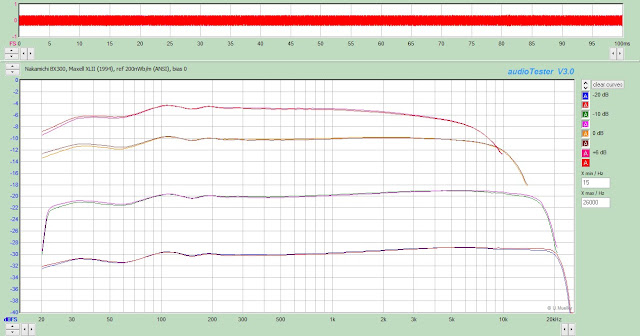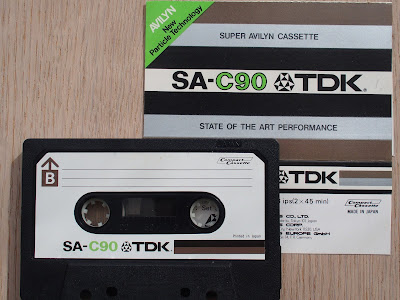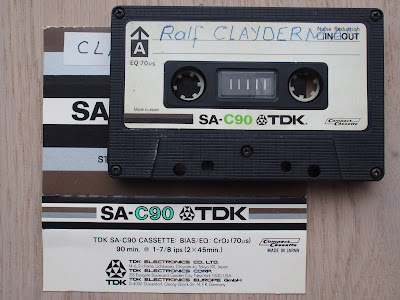Introduction
The TDK SA is, of course, a landmark. Possibly the most important cassette line ever conceived. It was born out of necessity:In the early seventies chromium dioxide tape was hailed as a big step up in quality. But it had its problems. The affordable heads of the day could not drive true chrome tapes at the high required bias level without saturation issues. Thus deck manufacturers deliberately underbiased their CrO2 settings, leading to midrange distortion and under-utilisation of the tape's dynamic range. Further, DuPont had given Sony the monopoly for distributing its chromium dioxide in Japan, to the detriment of the latter's competitors. (In Europe no such limiting arrangements were in place, and everyone could freely develop chrome cassettes.)
TDK solved these problems by offering SA, a cobalt-doped ferric tape optimised for chrome-underbiasing decks. You may want to read this tape review from 1976 for more background. (Cobalt doping existed before, see some Scotch cassettes and the Maxell UD-XL, but now it was for the first time pushed into the high bias slot.)
The rest is history. While the early-80s IEC II standard was (foolishly, because of the Sony monopoly) based on BASF's chrome dioxide, the Asian industry moved de-facto to SA-style tapes, and by 1987 the new BASF-made IEC II reference U564W was a near-copy of TDK SA.
Compared to chrome ferro-cobalt tapes initially had a much higher bias noise, only partially compensated by their high MOL. In 1985 TDK succeeded in reducing this noise significantly. Not much later a dynamic range of 64-66dB(A) became feasible.
All tapes were used, but contrary to the Maxells in this series, most were not originally owned by me. Many of these showed wear and sometimes some effort was required to find a spot suitable for measurements. I can also add that from 1985 on these tapes, even my own ones which have been well cared for, are mechanically very instable and prone to spontaneous railroading and other scary problems. This is probably the price paid for TDK's magnetic excellence, achieved by the aggressive calendering (polishing) of the tape surface.
Maxell XLII 90 (1994) (my calibration reference)
Relative bias: (reference)Relative sensitivity: (reference)
THD @ Dolby level: 0.62%
MOL400(THD=1%) : +1.8dB
MOL400(THD=3%): +5.3dB
MOL1k(THD=3%): +5.5dB
SOL10k: -3.4dB
Bias noise: -54.8dB, -59.2dB(A)
Dynamic range: 64.5dB
I repeat here the results for the tape my Nak BX-300 is calibrated for in type II position, the 1994 XLII. All following results take this as reference.
TDK SA (1974)
Relative bias: -5Relative sensitivity: +1.3dB
THD at Dolby Level: 0.95%
MOL400(1%): +0.2dB
MOL400(3%): +4.1dB
MOL1k(3%): +4.1dB
SOL10k: -4.9dB
Bias noise: -51.9dB, -55.1dB(A)
Dynamic range: 59.2dB
This is the very first version of SA. The bias point is conspicuously low, even at -5 it showed some treble loss, but sensitivity is high, and MOL is very decent. SOL is lowish. Still, in overall dynamic range this tape remained competitive until 1980 or so. Thoroughly impressive.
TDK SA (1975-1978)
Relative bias: -4Relative sensitivity: +0.8dB
THD at Dolby Level: 1.35%
MOL400(1%): -1.2dB
MOL400(3%): +3.1dB
MOL1k(3%): +3.0dB
SOL10k: -3.2dB
Bias noise: -51.3dB, -54.4dB(A)
Dynamic range: 57.5dB
SA's early version shell was already in 1975 replaced with one with a large window. Apparently the tape changed too, and not for the better. I am not sure if this is due to wear and ageing, or simply because TDK chose to improve SOL at the cost of MOL.
TDK SA (1979-1982)
Relative bias: -2.5Relative sensitivity: +1.3dB
THD at Dolby Level: 0.62%
MOL400(1%): +1.8dB
MOL400(3%): +5.4dB
MOL1k(3%): +5.3dB
SOL10k: -3.8dB
Bias noise: -51.2dB, -54.1dB(A)
Dynamic range: 59.5dB
From this time on TDK succeeded in offering high MOLs, and focused with later iterations mainly on reducing the bias noise. You can also see that from now on SA has been quite consistent through the years in terms of bias needs and sensitivity. But then that was almost a necessity, as Japan Inc. had elected SA to be their unofficial type II standard, ignoring two generations of chrome dioxide IEC type II reference tapes. And then, in 1987, IEC themselves changed the reference to ferro-cobalt, with compatibility parameters very very close to SA.
TDK SA (1982-1983)
Relative bias: -3Relative sensitivity: +1.4dB
THD at Dolby Level: 0.44%
MOL400(1%): +3.0dB
MOL400(3%): +6.3dB
MOL1k(3%): +5.6dB
SOL10k: -3.8dB
Bias noise: -51.9dB, -55.6dB(A)
Dynamic range: 61.9dB
TDK SA (1983-1985)

Relative bias: -2.5
Relative sensitivity: +0.9dB
THD at Dolby Level: 0.82%
MOL400(1%): +0.7dB
MOL400(3%): +4.8dB
MOL1k(3%): +4.5dB
SOL10k: -3.5dB
Bias noise: -52.2dB, -55.6dB(A)
Dynamic range: 60.4dB
TDK SA (1983-1985, late version)
Relative bias: -1Relative sensitivity: +0.4dB
THD at Dolby Level: 0.90%
MOL400(1%): +0.6dB
MOL400(3%): +4.7dB
MOL1k(3%): +5.0dB
SOL10k: -3.6dB
Bias noise: -53.6dB, -57.3dB(A)
Dynamic range: 62.0dB
This is a late sample, from 1985. It cannot be distinguished from the 1983 version, but it already contains the next-generation tape with significantly lower noise.
TDK SA (1985-1986)
Relative bias: -2.5Relative sensitivity: +0.7dB
THD at Dolby Level: 0.80%
MOL400(1%): +0.8dB
MOL400(3%): +4.9dB
MOL1k(3%): +5.0dB
SOL10k: -3.9dB
Bias noise: -53.6dB, -57.5dB(A)
Dynamic range: 62.4dB
This cassette looked pristine, jcard and all, but the tape had railroad creases right through both left channel tracks. All measurements are based on the right channel only. There is very little difference with the previous version, the tape itself is very likely the same.
TDK SA (1985-1987, USA)
Relative bias: -1.5Relative sensitivity: +0.4dB
THD at Dolby Level: 0.85%
MOL400(1%): +0.8dB
MOL400(3%): +4.8dB
MOL1k(3%): +4.9dB
SOL10k: -3.8dB
Bias noise: -54.6dB, -58.6dB(A)
Dynamic range: 63.4dB
TDK SA (1986-1988)
Relative bias: -1.5Relative sensitivity: +0.6dB
THD at Dolby Level: 0.75%
MOL400(1%): +1.5dB
MOL400(3%): +5.4dB
MOL1k(3%): +5.1dB
SOL10k: -4.1dB
Bias noise: -54.2dB, -58.3dB(A)
Dynamic range: 63.7dB
What Hi-Fi Blank Tape Special 1987 names this SA "a perfect match" for the "new IEC II reference". The article was published in October 1987, and so it must have been written in July or August. The introduction says "the latest IEC type II tape should be fully ratified by the time this test is published", so it is clear that U564W is meant, the BASF-made ferro-cobalt tape. The author was Paul Miller, one of the most rigorous tape testers in Europe, who would later on do the testing for Hi-Fi Choice.
TDK SA (1988-1990)
Relative bias: -2Relative sensitivity: +0.9dB
THD at Dolby Level: 0.58%
MOL400(1%): +2.3dB
MOL400(3%): +6.0dB
MOL1k(3%): +5.5dB
SOL10k: -3.4dB
Bias noise: -54.3dB, -58.4dB(A)
Dynamic range: 64.4dB
According to Hifi Choice April 1989 this SA is very close to IEC type II standard U564W.
TDK SA (1988-1990, US version)
Relative bias: -1.5Relative sensitivity: +1.0dB
THD at Dolby Level: 0.40%
MOL400(1%): +3.3dB
MOL400(3%): +6.4dB
MOL1k(3%): +6.1dB
SOL10k: -3.5dB
Bias noise: -54.3dB, -58.4dB(A)
Dynamic range: 64.8dB
This version was made in California, but could also be found on the European market.
TDK SA (1990-1992)
Relative bias: -2Relative sensitivity: +1.1dB
THD at Dolby Level: 0.42%
MOL400(1%): +3.1dB
MOL400(3%): +6.5dB
MOL1k(3%): +5.9dB
SOL10k: -2.6dB
Bias noise: -54.6dB, -58.7dB(A)
Dynamic range: 65.2dB
TDK SA (1992-1994)
Relative bias: -1.5Relative sensitivity: +1.4dB
THD at Dolby Level: 0.45%
MOL400(1%): +3.6dB
MOL400(3%): +7.1dB
MOL1k(3%): +6.6dB
SOL10k: -2.9dB
Bias noise: -54.4dB, -58.8dB(A)
Dynamic range: 65.9dB
TDK SA (1994-1997)
Relative bias: -2Relative sensitivity: +0.7dB
THD at Dolby Level: 0.53%
MOL400(1%): +2.4dB
MOL400(3%): +6.0dB
MOL1k(3%): +5.9dB
SOL10k: -3.6dB
Bias noise: -54.6dB, -59.0dB(A)
Dynamic range: 65.0dB
TDK SA (2008-2011)
Relative bias: +0.5Relative sensitivity: +0.7dB
THD at Dolby Level: 0.53%
MOL400(1%): +2.7dB
MOL400(3%): +6.4dB
MOL1k(3%): +5.7dB
SOL10k: -2.9dB
Bias noise: -52.5dB, -56.5dB(A)
Dynamic range: 62.9dB
I have two mint samples. Their date codes put them either in 1998 and 2000 or 2008 and 2010. They sport the 'Life On Record' brand, which makes them 2008. By this time the TDK magnetic tape brand was owned by Imation. These are not real SAs, in that they differ clearly in compatibility parameters and in bias noise from any recent true SA.
TDK SF (1985-1987)
Relative bias: -1Relative sensitivity: +0.1dB
THD at Dolby Level: 0.92%
MOL400(1%): +0.5dB
MOL400(3%): +4.4dB
MOL1k(3%): +4.3dB
SOL10k: -3.1dB
Bias noise: -52.0dB, -55.2dB(A)
Dynamic range: 59.6dB
At the end of 1985 TDK launched the SF, a cheaper type II to compete with Maxell's UDII. There are stories that SF tape was nothing else than last year's SA. In later days this was indeed true, as TDK confirmed themselves. The original SF, however, was a development from the ground up, as the above figures testify: they do not match any earlier SA.
TDK CDing II (1994-1996)
Relative bias: -1Relative sensitivity: +0.7dB
THD at Dolby Level: 0.9%
MOL400(1%): +0.6dB
MOL400(3%): +5.0dB
MOL1k(3%): +5.3dB
SOL10k: -3.2dB
Bias noise: -54.4dB, -58.6dB(A)
Dynamic range: 63.6dB
A budget model, coming in below SF, but using SF tape all the same. Vintagecassettes.com puts it in 1997, but Hi-Fi Choice already reviews it in January 1994!
TDK CDing II (1996-2002)
Relative bias: -1.5Relative sensitivity: +0.8dB
THD at Dolby Level: 0.93%
MOL400(1%): +0.5dB
MOL400(3%): +4.9dB
MOL1k(3%): +5.4dB
SOL10k: -3.4dB
Bias noise: -54.4dB, -58.9dB(A)
Dynamic range: 63.8dB
SF tape.
INDEX OF ALL CASSETTES




































